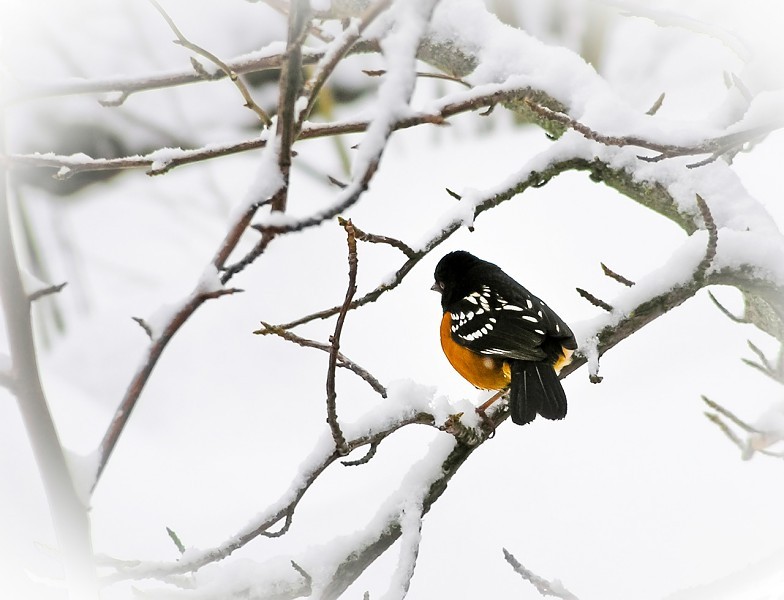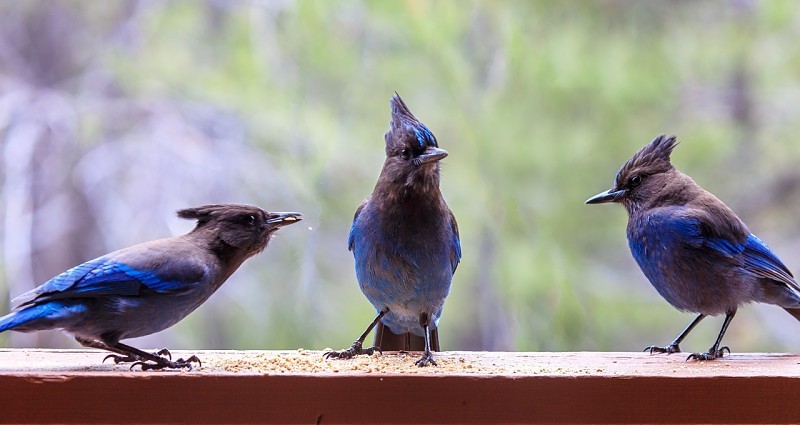Ever look out your window and see a dark-eyed junco foraging in the snow, or a spotted towhee (pictured right) sitting on a branch on a crisp, cold morning in January wondering how is he not frozen?
Well, birds are actually equipped to handle almost anything nature throws at them, and have many adaptations to deal with the cold:
Fluff up. As most probably know bird feathers provide great insulation. Your puffy down jacket is a great testament to this fact. To maximize their insulation capabilities, birds will often fluff up their feathers taking on the appearance of a very rounded, over-weight bird. In actuality the bird is doing this to create more space between their skin and feathers to generate warm air and keep out cold air.
Eat energy-rich foods. To maintain a high metabolic rate, birds will eat energy-rich foods like seeds, berries and fruits.
Stand on one leg. Huh? Yes, you heard right. Birds will often tuck in their head or tuck in a foot, up into their feathers to reduce their body surface area.
Find Shelter or Crowd Together. Pretty self-explanatory.

Photo courtesy of Rochelle Villanueva.
So the real take-home from this blog is that birds got it covered, right? Well, yes. Birds have survived winter conditions without our help for a very, very long time. Still, as humans we like help, don’t we. So for those generous bird-enthusiasts out there here are some things you can do in your yard or garden to help your backyard birds this winter:

Photo courtesy of Cindy Murphy.
Provide fatty, energy-rich foods
If you haven’t already, put up a suet feeder. Packed full of fatty-rich foods, these feeders will provide nuthatches, chickadees, wrens and woodpeckers a delicious energy-packed meal.
Don’t forget your tube feeders! These feeders are great wintertime bird feeders, packed full of energy-rich foods (i.e. seeds) while keeping seeds dry. These feeders will attract many different bird species including finches, sparrows, titmouse, jays,….
Remember to place feeders in a protected location out of the wind and cold.
Provide shelter
Evergreen plants provide great cover and wind protection for birds in the winter, so the more evergreen trees and shrubs on your property the better for birds. Also, birdhouses or bird roost boxes are great shelters for birds in winter time. You might consider taking some steps to winterize your bird houses and boxes to make them extra cozy for birds in the winter time. Here are some ideas for winterizing your bird houses.
Create bird habitat in your yard
There’s a lot of not-so-intuitive measures you can take in your yard or garden to create habitat for birds in winter. For instance, leaving some piles of leaves and sticks in your yard creates wintering habitat for insects and bugs that birds will seek out and eat. Planting native plants that produce berries in winter is another great way to provide shelter and an additional food source for birds in the winter. Even consider leaving your dried-up or dead garden plants in the ground. They will provide more habitat and possible food sources for birds in the winter.

